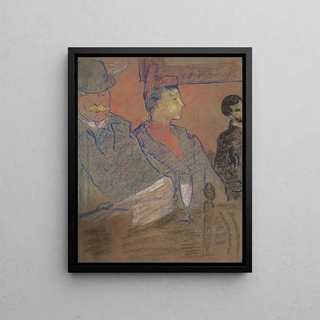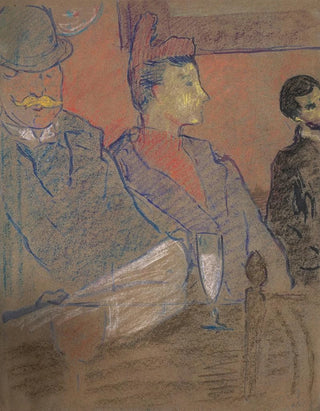Art print | La Dame au café - Louis Valtat


View from behind

Frame (optional)
Reproduction La Dame au café - Louis Valtat – Engaging introduction
In the vibrant world of art, "La Dame au café" by Louis Valtat stands out for its intimate atmosphere and refined elegance. This artwork, capturing a suspended moment in time, evokes the sweetness of a coffee break, a moment of contemplation and serenity. Light plays a leading role, illuminating the woman's face at the center of the composition, while warm tones and delicate shades create a cozy ambiance. Valtat, with his mastery of colorism, manages to transport the viewer into a cocoon of well-being, inviting reflection on the beauty of simple everyday moments.
Style and uniqueness of the work
Louis Valtat's style is firmly rooted in the Fauvist movement, where color is used not only to depict reality but also to express emotions. "La Dame au café" perfectly illustrates this approach. Bright, almost daring colors intertwine with touches of light that enhance the scene's depth. The composition, while figurative, reveals a certain abstraction, particularly in the outlines of objects and figures. This duality between realism and stylization gives the artwork a unique dynamism, captivating the eye and the mind. The presence of decorative motifs, typical of the early 20th century, further enriches the piece, creating a dialogue between the subject and its environment, and inviting the viewer to immerse themselves in this delicate world.
The artist and his influence
Louis Valtat, a French painter from the late 19th and early 20th centuries, is often regarded as a pioneer of Fauvism. His artistic journey is marked by an incessant quest for harmony between color and light. Influenced by masters such as Monet and Van Gogh, Valtat developed a personal style that combines the vibrancy of colors with a particular sensitivity to form. His work has captivated many contemporaries and has also inspired subsequent generations of artists. Through his creations, he contributed to redefining the codes of modern painting, emphasizing the importance of emotion and perception in

Matte finish

View from behind

Frame (optional)
Reproduction La Dame au café - Louis Valtat – Engaging introduction
In the vibrant world of art, "La Dame au café" by Louis Valtat stands out for its intimate atmosphere and refined elegance. This artwork, capturing a suspended moment in time, evokes the sweetness of a coffee break, a moment of contemplation and serenity. Light plays a leading role, illuminating the woman's face at the center of the composition, while warm tones and delicate shades create a cozy ambiance. Valtat, with his mastery of colorism, manages to transport the viewer into a cocoon of well-being, inviting reflection on the beauty of simple everyday moments.
Style and uniqueness of the work
Louis Valtat's style is firmly rooted in the Fauvist movement, where color is used not only to depict reality but also to express emotions. "La Dame au café" perfectly illustrates this approach. Bright, almost daring colors intertwine with touches of light that enhance the scene's depth. The composition, while figurative, reveals a certain abstraction, particularly in the outlines of objects and figures. This duality between realism and stylization gives the artwork a unique dynamism, captivating the eye and the mind. The presence of decorative motifs, typical of the early 20th century, further enriches the piece, creating a dialogue between the subject and its environment, and inviting the viewer to immerse themselves in this delicate world.
The artist and his influence
Louis Valtat, a French painter from the late 19th and early 20th centuries, is often regarded as a pioneer of Fauvism. His artistic journey is marked by an incessant quest for harmony between color and light. Influenced by masters such as Monet and Van Gogh, Valtat developed a personal style that combines the vibrancy of colors with a particular sensitivity to form. His work has captivated many contemporaries and has also inspired subsequent generations of artists. Through his creations, he contributed to redefining the codes of modern painting, emphasizing the importance of emotion and perception in






